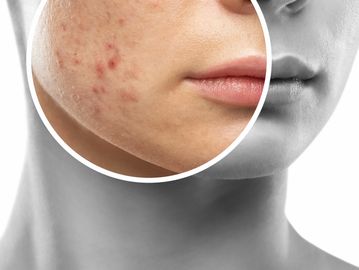Signed in as:
filler@godaddy.com
Signed in as:
filler@godaddy.com

These tiny pimple like spots have a center to them that is raised and prickly to the touch. They are often described as feeling like spots of sandpaper or a tiny sliver sticking out of the skin just slightly. Demodex can live anywhere on the body including arms and legs, hands and feet, but are more recognized as facial mites.

Demodex mites are white and off white in color and are usually a stark contrast to the redness of an irritated area. This is often adults embedded in the skin, a cluster of eggs, or the debris of dead mite bodies the immune system is trying to push out of the skin. Demodex mites do not defacate like scabies or lice do, their waste is contained until they die and then released into the body to be processed out. Too much waste throws off the bodies ability to cleanse and regulate itself creating

This is biofilm and the number one indicator for Demodex mites. Demodex are more common in older people and the areas affected by them are often referred to as age spots and liver spots They are often misdiagnosed as skin cancer. Biofilm is a living organism that works in tandem with parasites to encapsulate the heavy metals and toxins that parasites feed on aidin, but it‘s also the body’s way of encapsulating foreign invaders (the mites) to keep them from spreading to other parts of the body fo

These tiny pimple like spots have a center to them that is raised and prickly to the touch. Scabies mites are generally red whereas Demodex mites appear more flesh colored with white centers.

Mites burrow beneath the skin to take up residence. Female scabies mites burrow into a spot and stay there. Male mites come out of their burrows, especially at night, looking for females to mate. Once a female has been mated she is fertile for the rest of her life and will stay in her burrow, tunnel further into it, and lay her eggs. The burrow can be seen clearly as tiny dots strung together resembling a scratch or as a faint silvery line under the skin.

Scabies is prone to the webs of fingers and toes, waistbands, armpits, under the breasts, in the groin, in the ears, and, contrary to a lot of medical information, can live happily on the face and on the scalp. Scabies can live on the soles of the feet and the palms of the hands and is found under the nails and in the cuticles. There is research to suggest that toenail fungus is actually mites and mite damage to the skin barrier.

Areas of outbreak often times become inflamed as an immune response to something invading and taking up residence in the skin. The body is also working tirelessly to remove the waste, the damaged skin cells, and the invader itself from the system, bringing heat and white blood cells to the area.

Mites are opportunistic and will take advantage of any dark, oily, dry, cracked or compromised area of skin to dig down deep and multiple. They prefer the natural folds of joints and use the wrinkles and crevices to dig deeper in areas that are hard to reach. The creases of the wrists, the tops of the knuckles, the folds on the neck and the dark places under waistbands and breasts are all breeding grounds for ectoparasites. Skin tags (biofilm) will form in these areas.

Mites invade the top and underlying layers of the skin leaving the skin barrier compromised and vulnerable to dirt and pathogens. Bacterial infections are common with scabies or Demodex and are often diagnosed solely as impetigo and treated with antibiotics. The underlying point of entry for the bacteria is broken skin, either from the mites themselves, or from scratching affected areas.
Demodex follicular
Demodex brevis
Demodex is a genus of tiny mites that live in or near hair follicles of mammals. Around 65 species of Demodex are known.
Two species live on humans: Demodex folliculorum and Demodex brevis, both frequently referred to as eyelash mites, follicular mites, face mites or skin mites.
Demodex are microscopic mites that naturally lin human hair follicles and sebaceous (oil) glands, especially on the face, eyelashes, and eyebrows.
In small numbers, they usually cause no symptoms, but overgrowth can trigger or worsen skin conditions like rosacea, blepharitis (eyelid inflammation), and acne-like eruptions.
Symptoms can include itching, redness, scaling, and a “crawling sensation, often worse at night when the mites are more active.
Almost everyone has some Demodex mites, but their numbers tend to increase significantly with age.
Studies show:
Scabies is a contagious skin infestation caused by the microscopic mite Sarcoptes scabiei var. hominis.
The female mites burrow into the outer layer of the skin (epidermis) to lay eggs, triggering intense itching — especially at night — and a rash that often appears as small red bumps, blisters, or burrow lines.
It spreads through prolonged skin-to-skin contact and, less commonly, through infested bedding or clothing. Without treatment, the infestation can persist indefinitely and may lead to seco
Itching and rash can last weeks after mites are cleared due to residual allergens from mite bodies and waste.
This site is for educational purposes only and does not provide medical advice. Information here is not a substitute for professional diagnosis or treatment. Always seek the advice of a qualified healthcare provider for any questions about your health or a medical condition.
We use cookies to analyze website traffic and optimize your website experience. By accepting our use of cookies, your data will be aggregated with all other user data.